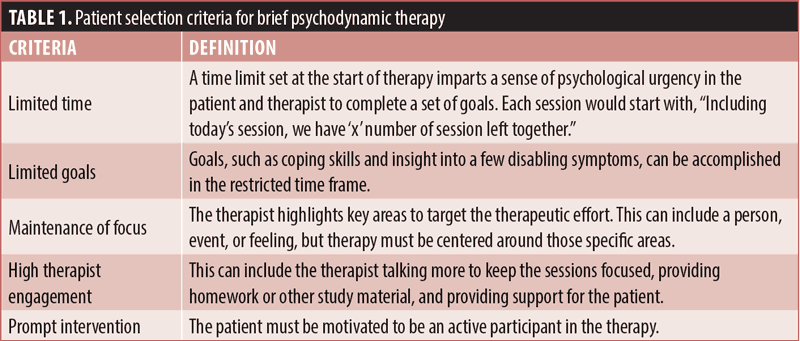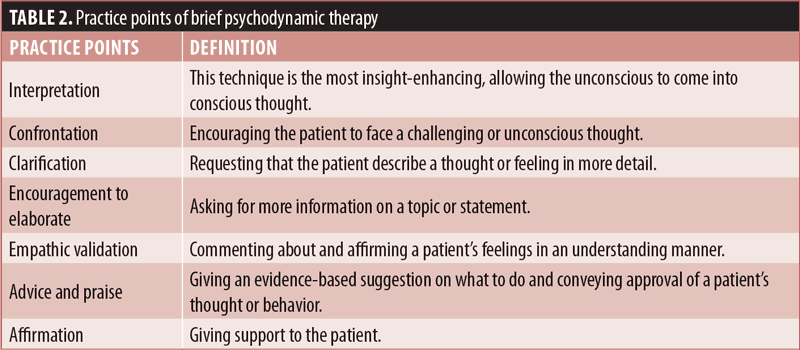
by Jessica Porcelan, MD, and Katherine Scribner
Dr. Porcelan is an Assistant Professor with Wright State University Boonshoft School of Medicine in Fairborn, Ohio. Ms. Scribner is a fourth-year medical school student with Wright State University Boonshoft School of Medicine in Fairborn, Ohio.
Funding: No funding was provided for this study.
Disclosures: The author has no conflicts of interest relevant to the content of this article.
Innov Clin Neurosci. 2022;19(1–3):52–55
ABSTRACT: In this fictional case vignette, the authors illustrate the inclusive criteria and supportive-interruptive continuum techniques utilized in brief psychodynamic therapy (BPT), a therapeutic strategy designed to shorten psychotherapy from months to weeks in certain types of patients. The authors provide examples of a fictional dialogue between a young adult patient with generalized anxiety disorder (GAD) and ruminating thoughts and her therapist to demonstrate how the therapeutic techniques of BPT (interpretation, confrontation, clarification, encouragement to elaborate, empathic validation, advice and praise, and affirmation) can be used in clinical practice. Each example dialogue is followed by a brief practice point discussion reviewing the technique(s) used. In addition to giving patients insight into their conflicts so that they can access appropriate coping skills, BPT techniques can also reveal important information about the patient to the clinician that might enhance treatment outcomes—in this case, undiagnosed obsessive-compulsive disorder (OCD), which was causing significant stress to the patient. This revelation subsequently led to a comorbid diagnosis of OCD, which was managed with appropriate pharmacotherapy, enhancing treatment outcomes for the patient. BPT continues to show promise in treating a wide variety of psychiatric conditions due to its time efficiency and effectiveness. Clinicians should note that adhering to the recommended patient selection criteria for BPT is imperative for good outcomes. Additional data are needed to assess what specific diagnoses are indicated for optimal results using this modality, as well as its long-term outcomes.
Keywords: Brief psychodynamic therapy, anxiety, obsessive-compulsive disorder, therapeutic rupture, therapeutic rupture repair, inclusion criterion for brief psychodynamic therapy
Department editor: Julie P. Gentile, MD, is Professor and Chair of the Department of Psychiatry at Wright State University in Dayton, Ohio.
Editor’s Note
The patient cases presented in Psychotherapy Rounds are composite cases written to illustrate certain diagnostic characteristics and to instruct on treatment techniques. The composite cases are not real patients in treatment. Any resemblance to a real patient is purely coincidental.
Psychodynamic therapy is an evidence-based treatment that focuses on inducing behavioral alterations in patients through gaining insight into the patterns of their past adverse experiences.1 Brief psychodynamic therapy (BPT) shortens the therapeutic window from years to months, usually involving fewer than 24 sessions.2 In differentiating between brief- and long-term psychodynamic therapy, short-term therapy was more efficacious at the one-year follow-up, and long-term therapy was more effective at the three- and five-year follow-ups.5 That said, short-term intervention shows modest-to-large gains for a wide variety of patients.3,4,6 However, the loss of significance in some outcome measures, symptom reduction, interpersonal problems, and social adjustment at long-term follow-up makes it imperative that patient selection criteria are strictly followed.4,5,7 When treating a patient with more than one disorder, the complexity through which the clinician must navigate increases exponentially. Using a fictional case vignette, this article exemplifies the inclusive criteria and supportive-interruptive continuum utilized in BPT.
Brief Psychodynamic Psychotherapy
The five main inclusion criteria used to determine an ideal patient for BPT are limited time, limited goals, maintenance of focus, high therapist engagement, and prompt intervention (Table 1).7,8 The foundation of BPT is focused on the supportive-interpretive continuum (Table 2).2 The intervention techniques—interpretation, confrontation, clarification, and encouragement to elaborate—allow the therapist to challenge a maladaptive behavior with the aim of giving patients insight into their long-lasting conflicts and issues.9 The supportive techniques—advice and praise, empathic validation, and affirmation—can enhance a patient’s access to abilities that might be blocked by underdevelopment or acute stress.10 These techniques are used in acute or severe cases of mental illness. Additionally, supportive statements are used to reinforce the growth and progress achieved in therapy. Regardless of which set of techniques are used at the beginning of therapy, therapists must always be mindful of the way they ask questions or offer support. Empathy is of the utmost importance during BPT.2 In the following fictional case vignette, the inclusion criterion and techniques of BPT are demonstrated through patient-therapist dialogue, followed by practice point discussions.


Fictional Case Vignette
Patient C was a 26-year-old woman with a past psychiatric history of generalized anxiety disorder (GAD) who presented with severe anxiety, restlessness, fatigue, irritability, and “thoughts getting stuck.” Patient C reported that these symptoms started in high school and progressively worsened over the last six months. Her primary care physician (PCP) trialed numerous psychiatric medications, none of which achieved satisfactory results, including escitalopram, gabapentin, clonazepam, venlafaxine, hydroxyzine, buspirone, nadolol, topiramate, and quetiapine, the last of which the patient was in the process of tapering off due to side effects of weight gain and fatigue. The PCP recommended that the patient see a therapist due to medication ineffectiveness and worsening of anxiety symptoms in the context of psychosocial stress, specifically family and relationship distress with her partner, R. Her stated goal was gaining self-confidence and not relying so heavily on others for her emotional well-being. The following dialogues focus on different aspects of BPT and the tools used to facilitate the therapy.
Dialogue 1
Therapist: I understand that you had a rough few weeks. Can you tell me more about that?
Patient: I can’t seem to control my anxiety at all. I feel sick to my stomach all the time.
Therapist: Can you think of a reason why you are feeling anxious?
Patient: Yesterday was R’s birthday, and I’m worried that I’m not doing a good enough job.
Therapist: Did R say something to make you think that?
Patient: No, but we have been doing so well recently…so something has to go wrong soon.
Therapist: Has something happened in the past to make you feel that way?
Patient: Well, when I moved away from my parents for the first time eight years ago, it felt good to have some independence. I thought things were going well, but my parents took it as a sign of me not loving them. I felt so sad and caught off guard—it has really stuck with me.
Practice point: Clarification and Encouragement to Elaborate
In Dialogue 1, the therapist used the intervention tools of clarification and encouragement to elaborate to uncover an unconscious reason why the patient felt anxious when things were going well. With this new insight into her subconscious, the patient could begin to separate the unconscious anxiety-provoking thoughts from her conscious reality.
Clinical Vignette, Continued: Dialogue 2
Patient: R never puts away the dishes, and, rather than saying something, I just do it myself. Thinking about saying something to R makes me so anxious that it just doesn’t seem worth it to ever mention it.
Therapist: It seems like you avoid conflict with your boyfriend because conflict makes you feel more anxious.
Patient: Um…doctor…R is my girlfriend.
Therapist: Oh my goodness! I apologize. I’d like to stop the session and talk about this.
Patient: It’s okay. It happens a lot. R is a unisex name.
Therapist: I recognize that R is a unisex name, and you say it happens a lot. I wonder what feelings come to the surface when I and others assume your partner is a man.
Patient: It makes me feel a little frustrated, but your apology means a lot.
Therapist: I hope therapy is a space where you can share how my comments make you feel. Our interactions in the room will often mirror or parallel the things you experience in the world as well.
Practice Point: Confrontation and Clarification
In Dialogue 2, there was a potential therapeutic rupture or a strain in the emotional bond between therapist and patient, which could result in deterioration of trust if not addressed.12 The therapist realized her subconscious bias caused this rupture and immediately paused the session to discuss the rupture. This allowed the patient to discuss the impact on her emotions, which allowed the therapist and patient to quickly shift from rupture to repair.13
Clinical Vignette, Continued: Dialogue 3
Patient: I need to have better control of my emotions; I can’t lose R or my friends.
Therapist: Why do you think you will lose them if you show your emotions?
Patient: My family has had anger issues in the past.
Therapist: Anger issues?
Patient: My mom has rage issues; so does my grandfather. He once broke my grandma’s arm and told the family he was going to kill them while he had a gun in his hand.
Therapist: That must have been very scary. It is understandable that you would want to keep those feelings buried. Do you feel anger sometimes?
Patient: Sometimes…I mean, not like “break someone’s arm” angry. I guess I feel the angriest at my family for not accepting my sexual orientation. They are super religious. They say I can’t bring R around if Grandma is there. They tell me that Grandma couldn’t handle me being gay and that it would be selfish if I made her go through that pain.
Therapist: That must be so hard to hear from your family.
Practice Point: Encouragement to Elaborate and Empathic Validation
In Dialogue 3, Patient C was encouraged to reveal the connection between acute worry of expressing emotions and past life experiences. The therapist provided empathic validation by affirming the patient’s feelings in an understanding manner. Accepting herself as part of the LGBTQ+ community was a major source of anxiety for the patient.
Clinical Vignette, Continued: Dialogue 4
Patient: Sometimes, I get thoughts stuck in my head, and it feels impossible to get them out. Today I am stuck on death. Honestly, I often get stuck on death. I don’t want to die; I am scared of dying. It used to be much worse in college. I would stay up all night researching it for hours and hours. I wouldn’t get my schoolwork done, and it really impacted my ability to function.
Therapist: Do you feel like doing the research was the only way to get the thoughts out?
Patient: Yes, exactly. If I didn’t complete the research, then the thoughts would just keep spinning in there. It was debilitating.
Therapist: Did you feel some relief when you did the research?
Patient: So much relief! It was the only way I could move on through my day.
Therapist: That must have been a difficult time for you. Why do you think you are stuck on death again today?
Patient: Last night I had a dream about my friend who died by suicide last year. Since I woke up this morning, I just keep thinking about death.
Therapist: Do you think your fear of death is related to the fear of not being important to others…not leaving your mark on the world?
Patient: That sounds right. I rely on everyone else to make me feel important, so I can’t be proud of myself.
Practice Point: Interpretation, Confrontation, and Encouragement to Elaborate
In Dialogue 4, the therapist uncovered a possible secondary diagnosis of obsessive-compulsive disorder (OCD). The patient showed a recurrent thought that was only alleviated by performing the compulsive behavior of extensively researching the recurring thought. The compulsion was time consuming and resulted in significant impairment in functioning. Once diagnosis was confirmed, Patient C was started on fluoxetine for medication management of OCD symtpoms.11
Clinical Vignette, Continued: Dialogue 5
Therapist: Including our session today, we have three sessions left together. Where would you like to start today?
Patient: Three sessions left? Wow! With only a short amount of time, I guess we need to get into it. I really want to tell you about the interaction I had with my grandma. I decided to tell Grandma that I am gay.
Therapist: Why do you think you did that?
Patient: I finally feel comfortable sharing with people. I am proud of who I am and who I love. I am finished hiding it.
Therapist: Wow! That is such a big change from when we started working together.
Patient: I finally have more self-confidence. I feel like I have more control over the outcome of my own life. I’ve realized it is too unpredictable relying on everyone else. I guess that is the ”internal locus of control” that you always talk about.
Therapist: May I ask how your grandma received the information?
Patient: [laughs] She said, “Oh, I already know, honey. I love you no matter what.” And then she told me how she dated a few women in her 20s before marrying Grandpa, but that it was so taboo back then she never felt it was an option for her. She told me she is happy that I can be myself.
Therapist: Incredible! It seems like you shared with her when it was the right time for you.
Practice point: Praise and Affirmation
In Dialogue 5, the therapist used praise and affirmation to convey approval of and provide support for Patient C’s actions. This approach is appropriate at the end of therapy to reinforce the growth the patient has achieved during therapy. During the intake sessions, the patient stated that she felt desperate for people to “save” her emotionally. By the end of the BPT sessions, she stated that she was more in control of her emotions and felt less dependent on those around her. This demonstrates her improved internal locus of control.
Resolution of Therapy
Patient C was a good candidate for BPT because she met all the inclusion criteria: limited time and goals, maintenance of focus, high therapist engagement, and prompt intervention. She completed four intake sessions and 12 therapeutic sessions that were focused on mitigating her anxiety and improving her internal locus of control. While the patient reported she was sad that therapy was ending, she felt confident enough in herself to manage without it. The patient was a very active participant in therapy and was willing to put in the effort to make the “in the room” work successful.
Conclusion
BPT is an evidence-based intervention for treating maladaptive behaviors within the context of a limited amount of time. Due to the shortened therapy time, the therapist must be able to adapt and overcome unforeseen challenges and quickly build rapport with the patient. During sessions, the therapist should maintain a targeted approach to therapy. This often requires the identification of two or three main goals developed by the patient and therapist. However, while this therapy requires structure, the therapist should ensure that it does not become rigid. Overall, the patient-therapist dynamic is critically important during BPT therapy and should be prioritized throughout treatment. Additionally, proper patient selection for this treatment modality is imperative. More data are needed to assess what specific diagnoses are indicated for optimal results using this modality, as well as its long-term outcomes.
References
- Wallerstein RS. The Psychotherapy Research Project of the Menninger Foundation: an overview. J Consult Clin Psychol. 1989;57(2):195–205.
- Leichsenring F, Hiller W, Weissberg M, Leibing E. Cognitive-behavioral therapy and psychodynamic psychotherapy: techniques, efficacy, and indications. Am J Psychother. 2006;60(3):233–259.
- Svartberg M, Stiles T, Seltzer, MH. Randomized, controlled trial of the effectiveness of short-term dynamic psychotherapy and cognitive therapy for Cluster C personality disorders. Am J Psychiatry. 2004;161(5):810-817.
- Abbass AA, Kisely SR, Town JM, et al. Short-term psychodynamic psychotherapies for common mental disorders. Cochrane Database Syst Rev. 2014;(7):CD004687.
- Knekt P, Lindfors O, Sares-Jäske L, et al. Randomized trial on the effectiveness of long- and short-term psychotherapy on psychiatric symptoms and working ability during a 5-year follow-up. Nord J Psychiatry. 2013;67(1):59–68.
- Sharma P, Rosário MC, Ferrão YA, et al. The impact of generalized anxiety disorder in obsessive-compulsive disorder patients. Psychiatry Res. 2021;300(7–8):113898.
- Koss MP, Strupp HH, Butcher JN. Brief psychotherapy methods in clinical research. J Consult Clin Psychol. 1986;54(1):60–64.
- Messer SB. What makes brief psychodynamic therapy time efficient. Clin Psychol: Sci. 2001;8(1):5–22.
- Gabbard GO. Psychodynamic Psychiatry in Clinical Practice, 3rd Ed. Washington, DC: American Psychiatric Press; 2000.
- Bellak L, Hurvich M, Gediman H. Ego Functions in Schizophrenics, Neurotics, and Normals. New York: Wiley; 1973.
- American Psychiatric Association. Diagnostic and Statistical Manual of Mental Disorders, 5th Ed. Arlington, VA: American Psychiatric Association; 2013.
- Eubanks CF, Muran JC, Safran JD. Alliance rupture repair: a meta-analysis. Psychother. 2018;55(4):508–519.
- Walser RD, O’Connell M. Acceptance and commitment therapy and the therapeutic relationship: rupture and repair. J Clin Psychol. 2021;77(2):429–440.





